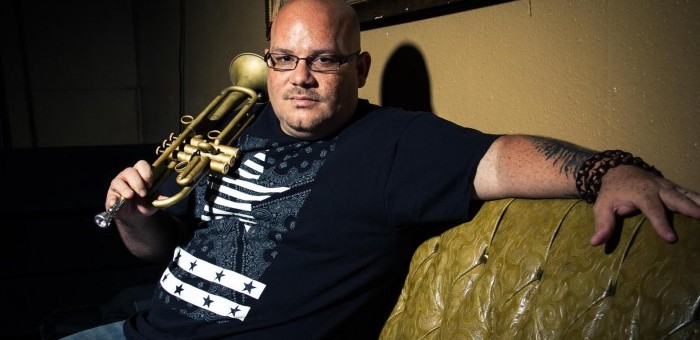Jun 3, 2025 11:25 AM
In Memoriam: Al Foster, 1943–2025
Al Foster, a drummer regarded for his fluency across the bebop, post-bop and funk/fusion lineages of jazz, died May 28…

Farnell Newton started Jam of the Week in 2014.
(Photo: Courtesy Royal Artist Group)You may have seen trumpeter Mark Kelly’s performance of Miles Davis’ “Milestones” in front of a classroom of singing and clapping third graders. This joyous 75-second video clip was posted to the popular Jam of the Week Facebook group and received more than 2,200 reactions and over 100 remarks.
That Facebook group and its corresponding online forum were founded by another trumpeter, Farnell Newton, in January 2014. Since its inception, it has grown to accommodate more than 50,000 members. DownBeat spoke with the Portland, Oregon, resident about this popular online community in advance of the release of his new album, Back To Earth, due out June 9 by Posi-Tone Records.
What’s the origin story behind Jam of the Week?
When I started using social media, Instagram only let you do 15 seconds of video. I was, like, “What can I do as a jazz musician in 15 seconds?” And I said, “I could play a blues, and it has to be pretty damn fast.” (Laughs)
So I said, “Well, let me do an let me do an F blues. That’s pretty easy on the trumpet.” I made a video, posted it up and tagged a bunch of my trumpet friends only. It was like a brass challenge.
Then next thing I know, I was getting tagged by all these people on Instagram—saxophonists, then pianists. At the time, Instagram had the function where you could share to Facebook. So now people on Facebook are tagging me. And they’re doing it at different tempos, and they’re still doing it all in the key of F.
So you were viral right from the start.
I was like, “Wow, all of these people! What am I going to do?” I’m talking to my wife; she’s been sounding board through this whole crazy experience. Then I decided to start a [Facebook] group, because it just works out better—the flow of traffic and people posting.
The first week we had around 200 members from around the country.
You choose each week’s topics—the music of Freddie Hubbard or the 1980s, for example. Is that ever a challenge?
No, it’s not at all. And some weeks I let everyone choose. I literally put a poll up. And then people post their suggestions, and they vote.
Unlike YouTube’s infamous comment sections, Jam of the Week’s replies are overwhelmingly positive and thoughtful. How do you maintain that atmosphere?
I was a professor at Portland State University for four years, and my goal was really helping people by being more constructive rather than just breaking them all the way down.
So I said, “Well, let’s have it be constructive criticism.” Don’t just get on there and say, “You suck.” Say that “you did a great job but the timing was a little off. Maybe you should work on doing this.”
Once an educator, always an educator.
And then another obstacle was also making sure the members were respectful—especially to female musicians. Because, you know, jazz is just like most music genres in that it’s very male-driven.
So no virtual catcalling. Try to keep it a space that people feel safe and also inspired.
Any submissions stand out to you?
Oh, yeah. Every week there are plenty of musicians. One of the ones who really shocked me was a Syrian singer who’s studying jazz in France. And for “transcription week” she did Charlie Parker’s, I want to say, “Chi Chi.”
And she not only scatted his solo note for note. But for the melody, she sang it in Arabic. This is the type of person I probably would have never met in my life.
It’s truly a worldwide web.
It totally is. I’ll see, for example, Terell Stafford and Tim Warfield—these guys who I grew up listening to and learning their solos. And they come up to me and they’re like, “Dude, we really like what you’re doing. Keep it up!”
Wherever I go, I try to videotape musician friends who are connected through Jam of the Week—Jaleel Shaw and Marquis Hill and all these guys.
And I was introduced to Grace Kelly through Jam of the Week. When I finally met her, she gave me a big ol’ hug and said, “Thank you for what you’ve done!” DB

Foster was truly a drummer to the stars, including Miles Davis, Sonny Rollins and Joe Henderson.
Jun 3, 2025 11:25 AM
Al Foster, a drummer regarded for his fluency across the bebop, post-bop and funk/fusion lineages of jazz, died May 28…

“Branford’s playing has steadily improved,” says younger brother Wynton Marsalis. “He’s just gotten more and more serious.”
May 20, 2025 11:58 AM
Branford Marsalis was on the road again. Coffee cup in hand, the saxophonist — sporting a gray hoodie and a look of…

“What did I want more of when I was this age?” Sasha Berliner asks when she’s in her teaching mode.
May 13, 2025 12:39 PM
Part of the jazz vibraphone conversation since her late teens, Sasha Berliner has long come across as a fully formed…

Roscoe Mitchell will receive a Lifetime Achievement award at this year’s Vision Festival.
May 27, 2025 6:21 PM
Arts for Art has announced the full lineup for the 2025 Vision Festival, which will run June 2–7 at Roulette…

Benny Benack III and his quartet took the Midwest Jazz Collective’s route for a test run this spring.
Jun 3, 2025 10:31 AM
The time and labor required to tour is, for many musicians, daunting at best and prohibitive at worst. It’s hardly…